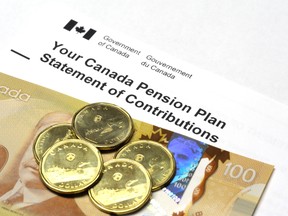Empty nesters wonder if they have saved enough to retire and when to take CPP and OAS

Empty nesters wonder if they have saved enough to retire and when to take CPP and OAS

Article content
Married nearly 30 years, Laurence* and Sandra are officially empty nesters. Their two adult children are independent and building their careers and the couple are ready to fully embrace their next chapter — if they have saved enough.
THIS CONTENT IS RESERVED FOR SUBSCRIBERS ONLY
Subscribe now to read the latest news in your city and across Canada.
- Exclusive articles from Barbara Shecter, Joe O'Connor, Gabriel Friedman, and others.
- Daily content from Financial Times, the world's leading global business publication.
- Unlimited online access to read articles from Financial Post, National Post and 15 news sites across Canada with one account.
- National Post ePaper, an electronic replica of the print edition to view on any device, share and comment on.
- Daily puzzles, including the New York Times Crossword.
SUBSCRIBE TO UNLOCK MORE ARTICLES
Subscribe now to read the latest news in your city and across Canada.
- Exclusive articles from Barbara Shecter, Joe O'Connor, Gabriel Friedman and others.
- Daily content from Financial Times, the world's leading global business publication.
- Unlimited online access to read articles from Financial Post, National Post and 15 news sites across Canada with one account.
- National Post ePaper, an electronic replica of the print edition to view on any device, share and comment on.
- Daily puzzles, including the New York Times Crossword.
REGISTER / SIGN IN TO UNLOCK MORE ARTICLES
Create an account or sign in to continue with your reading experience.
- Access articles from across Canada with one account.
- Share your thoughts and join the conversation in the comments.
- Enjoy additional articles per month.
- Get email updates from your favourite authors.
THIS ARTICLE IS FREE TO READ REGISTER TO UNLOCK.
Create an account or sign in to continue with your reading experience.
- Access articles from across Canada with one account
- Share your thoughts and join the conversation in the comments
- Enjoy additional articles per month
- Get email updates from your favourite authors
Sign In or Create an Account
or
Article content
Laurence is 58 and would like to retire by the end of this year. Sandra is 61, retired in 2019 and hasn’t looked back. The couple live in Ontario. Their primary residence is valued at $1.2 million. They own it mortgage-free and have no plans to sell. They also own about 50 acres of farmland, also mortgage free, which generates about $10,000 in gross annual income. They view the property as part of their children’s inheritance.
Article content
Article content
Article content
Laurence earns $148,000 in annual income before tax, while Sandra receives $58,000 a year before tax from her former employer’s defined benefit pension plan. The plan includes a Canada Pension Plan (CPP) bridge amount of $7,700 until she turns 65, at which time she will no longer receive the top-up.
Article content
By signing up you consent to receive the above newsletter from Postmedia Network Inc.
Article content
Laurence will receive about $830 a month in CPP payments at age 60. This increases to about $1,300 a month at 65 and about $1,800 a month at age 70. Sandra’s CPP benefits are about $816 a month at age 60, $1,160 at age 65 and $1,600 at 70.
Article content
“When should we start to take CPP and Old Age Security (OAS) benefits?” asked Laurence.
Article content
The couple’s investment portfolio includes nearly $1.1 million in registered retirement savings plans (RRSPs) of $660,000 for Laurence and $433,000 for Sandra. The accounts are largely invested in equities across diverse industries, and in cash. Laurence continues to maximize contributions while Sandra stopped contributing to her RRSP when she retired. Laurence also has $200,000 in a locked-in retirement account (LIRA). Both Laurence and Sandra have tax-free savings accounts (TFSAs) with a combined value of nearly $360,000, almost equally split. The LIRA and TFSAs are also invested largely in stocks. They both maximize their TFSA contributions each year. All of their investment accounts are managed by a fee-based portfolio manager.
Article content
Article content
In addition to their investments, Laurence has a $100,000 whole life insurance policy that costs $750 a year and Sandra has two $50,000 permanent life insurance policies that cost about $1,500 a year. “We’ve had these policies for years, but they are not earmarked for anything in particular,” said Laurence.
Article content
Article content
The couple’s monthly expenses total about $9,000, an amount Laurence expects will likely continue in retirement, as they don’t plan on any significant lifestyle changes. Neither Laurence nor Sandra has any plans to work in retirement.
Article content
“Have we saved enough to allow me to retire this year?” Laurence wants to know. “And what can we do to ensure we keep our tax costs to a minimum?”
Article content
What the expert says
Article content
Laurence and Sandra have done the right things to place themselves in a great position for Laurence to retire this year, said Eliott Einarson, a retirement planner at Ottawa-based Exponent Investment Management. They have paid off all debts, saved well through their working years, diversified their investments and successfully become empty nesters with independent adult children.




